2008 FIAT SEDICI warning lights
[x] Cancel search: warning lightsPage 151 of 266
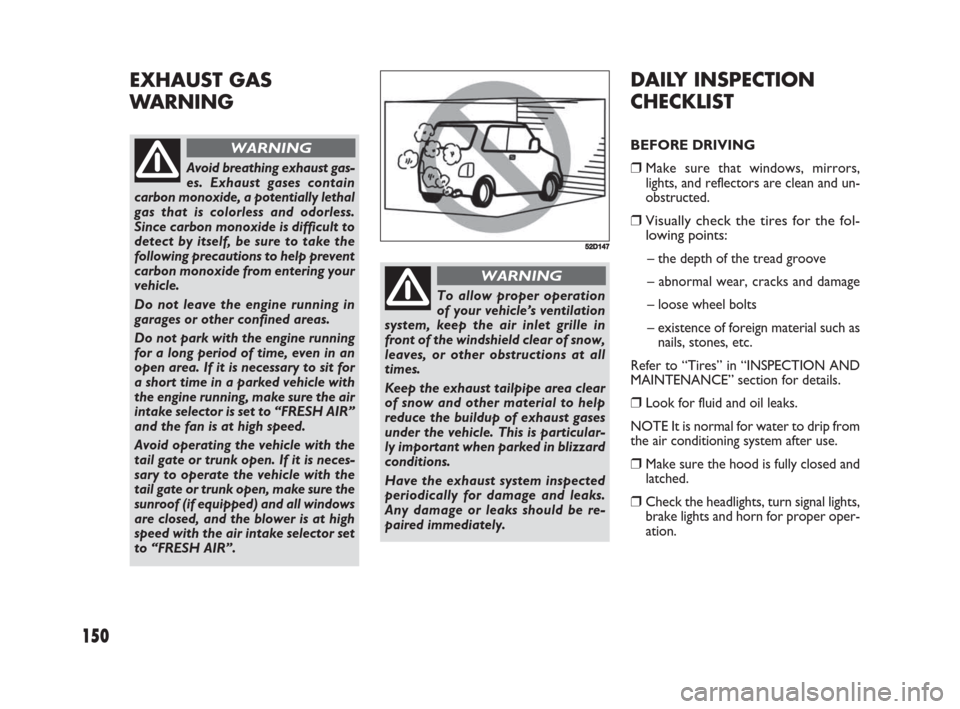
150
DAILY INSPECTION
CHECKLIST
BEFORE DRIVING
❒Make sure that windows, mirrors,
lights, and reflectors are clean and un-
obstructed.
❒Visually check the tires for the fol-
lowing points:
– the depth of the tread groove
– abnormal wear, cracks and damage
– loose wheel bolts
– existence of foreign material such as
nails, stones, etc.
Refer to “Tires” in “INSPECTION AND
MAINTENANCE” section for details.
❒Look for fluid and oil leaks.
NOTE It is normal for water to drip from
the air conditioning system after use.
❒Make sure the hood is fully closed and
latched.
❒Check the headlights, turn signal lights,
brake lights and horn for proper oper-
ation.
EXHAUST GAS
WARNING
52D147
Avoid breathing exhaust gas-
es. Exhaust gases contain
carbon monoxide, a potentially lethal
gas that is colorless and odorless.
Since carbon monoxide is difficult to
detect by itself, be sure to take the
following precautions to help prevent
carbon monoxide from entering your
vehicle.
Do not leave the engine running in
garages or other confined areas.
Do not park with the engine running
for a long period of time, even in an
open area. If it is necessary to sit for
a short time in a parked vehicle with
the engine running, make sure the air
intake selector is set to “FRESH AIR”
and the fan is at high speed.
Avoid operating the vehicle with the
tail gate or trunk open. If it is neces-
sary to operate the vehicle with the
tail gate or trunk open, make sure the
sunroof (if equipped) and all windows
are closed, and the blower is at high
speed with the air intake selector set
to “FRESH AIR”.
WARNING
To allow proper operation
of your vehicle’s ventilation
system, keep the air inlet grille in
front of the windshield clear of snow,
leaves, or other obstructions at all
times.
Keep the exhaust tailpipe area clear
of snow and other material to help
reduce the buildup of exhaust gases
under the vehicle. This is particular-
ly important when parked in blizzard
conditions.
Have the exhaust system inspected
periodically for damage and leaks.
Any damage or leaks should be re-
paired immediately.
WARNING
149-166 Fiat16 New GB 3-09-2008 8:15 Pagina 150
Page 152 of 266

151
Once a week, or each time you fill your
fuel tank, perform the following under-
hood checks:
❒Engine oil level
❒Coolant level
❒Brake fluid level
❒Power steering (if equipped) fluid level
❒Windshield washer fluid level
❒Battery solution level
❒Hood latch operation
Pull the hood release handle inside the
vehicle. Make sure that you cannot
open the hood all the way without re-
leasing the secondary latch. Be sure to
close the hood securely after check-
ing for proper latch operation. See “All
latches, hinges & locks” of “CHASSIS
AND BODY” in the “Periodic Main-
tenance Schedule” in the “INSPEC-
TION AND MAINTENANCE” section
for lubrication schedule.Once a month, or each time you fill your
fuel tank, check the tire pressure using a
tire pressure gauge. Also check the tire
pressure of the spare tire.❒Adjust the seat and adjustable head re-
straint (if equipped).
❒Check the brake pedal and the park-
ing brake lever.
❒Adjust the mirrors.
❒Make sure that you and all passengers
have properly fastened your seat belts.
❒Make sure that all warning lights come
on as the key is turned to the “ON” or
“START” position.
❒Check all gauges.
❒Make sure that the BRAKE SYSTEM
WARNING light turns off when the
parking brake is released.
60A187S
Make sure the hood is fully
closed and latched before
driving. If it is not, it can fly up un-
expectedly during driving, obstructing
your view and resulting in an acci-
dent.
WARNING
149-166 Fiat16 New GB 3-09-2008 8:15 Pagina 151
Page 164 of 266
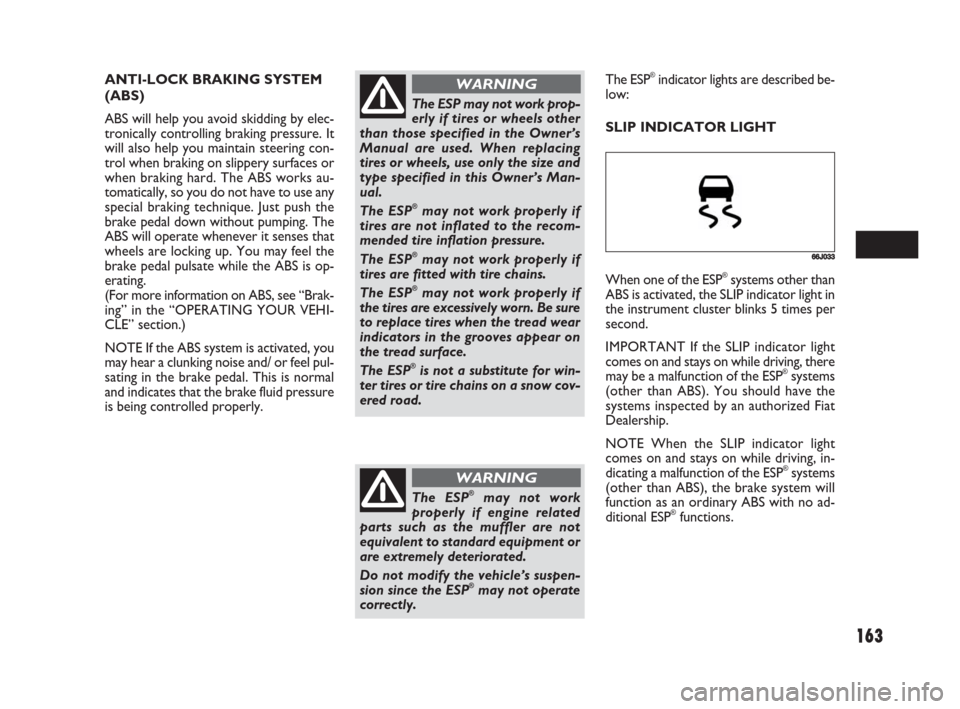
163
The ESP may not work prop-
erly if tires or wheels other
than those specified in the Owner’s
Manual are used. When replacing
tires or wheels, use only the size and
type specified in this Owner’s Man-
ual.
The ESP
®may not work properly if
tires are not inflated to the recom-
mended tire inflation pressure.
The ESP
®may not work properly if
tires are fitted with tire chains.
The ESP
®may not work properly if
the tires are excessively worn. Be sure
to replace tires when the tread wear
indicators in the grooves appear on
the tread surface.
The ESP
®is not a substitute for win-
ter tires or tire chains on a snow cov-
ered road.
WARNING
The ESP®may not work
properly if engine related
parts such as the muffler are not
equivalent to standard equipment or
are extremely deteriorated.
Do not modify the vehicle’s suspen-
sion since the ESP
®may not operate
correctly.
WARNING
ANTI-LOCK BRAKING SYSTEM
(ABS)
ABS will help you avoid skidding by elec-
tronically controlling braking pressure. It
will also help you maintain steering con-
trol when braking on slippery surfaces or
when braking hard. The ABS works au-
tomatically, so you do not have to use any
special braking technique. Just push the
brake pedal down without pumping. The
ABS will operate whenever it senses that
wheels are locking up. You may feel the
brake pedal pulsate while the ABS is op-
erating.
(For more information on ABS, see “Brak-
ing” in the “OPERATING YOUR VEHI-
CLE” section.)
NOTE If the ABS system is activated, you
may hear a clunking noise and/ or feel pul-
sating in the brake pedal. This is normal
and indicates that the brake fluid pressure
is being controlled properly.The ESP®indicator lights are described be-
low:
SLIP INDICATOR LIGHT
66J033
When one of the ESP®systems other than
ABS is activated, the SLIP indicator light in
the instrument cluster blinks 5 times per
second.
IMPORTANT If the SLIP indicator light
comes on and stays on while driving, there
may be a malfunction of the ESP
®systems
(other than ABS). You should have the
systems inspected by an authorized Fiat
Dealership.
NOTE When the SLIP indicator light
comes on and stays on while driving, in-
dicating a malfunction of the ESP
®systems
(other than ABS), the brake system will
function as an ordinary ABS with no ad-
ditional ESP
®functions.
149-166 Fiat16 New GB 3-09-2008 8:15 Pagina 163
Page 167 of 266
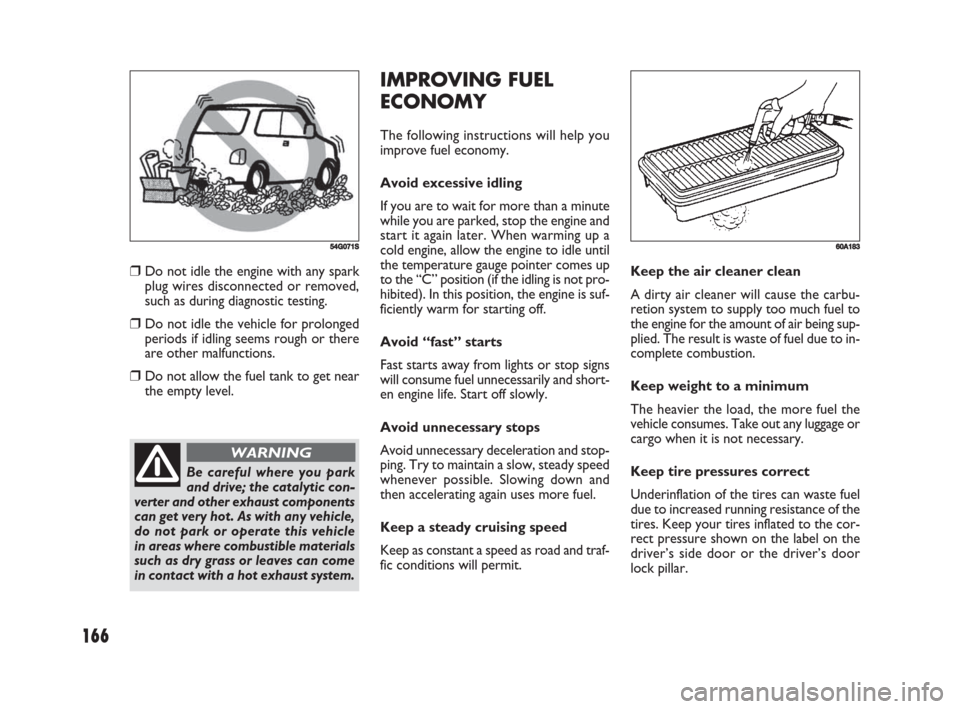
166
IMPROVING FUEL
ECONOMY
The following instructions will help you
improve fuel economy.
Avoid excessive idling
If you are to wait for more than a minute
while you are parked, stop the engine and
start it again later. When warming up a
cold engine, allow the engine to idle until
the temperature gauge pointer comes up
to the “C” position (if the idling is not pro-
hibited). In this position, the engine is suf-
ficiently warm for starting off.
Avoid “fast” starts
Fast starts away from lights or stop signs
will consume fuel unnecessarily and short-
en engine life. Start off slowly.
Avoid unnecessary stops
Avoid unnecessary deceleration and stop-
ping. Try to maintain a slow, steady speed
whenever possible. Slowing down and
then accelerating again uses more fuel.
Keep a steady cruising speed
Keep as constant a speed as road and traf-
fic conditions will permit.Keep the air cleaner clean
A dirty air cleaner will cause the carbu-
retion system to supply too much fuel to
the engine for the amount of air being sup-
plied. The result is waste of fuel due to in-
complete combustion.
Keep weight to a minimum
The heavier the load, the more fuel the
vehicle consumes. Take out any luggage or
cargo when it is not necessary.
Keep tire pressures correct
Underinflation of the tires can waste fuel
due to increased running resistance of the
tires. Keep your tires inflated to the cor-
rect pressure shown on the label on the
driver’s side door or the driver’s door
lock pillar.
60A183
❒Do not idle the engine with any spark
plug wires disconnected or removed,
such as during diagnostic testing.
❒Do not idle the vehicle for prolonged
periods if idling seems rough or there
are other malfunctions.
❒Do not allow the fuel tank to get near
the empty level.
54G071S
Be careful where you park
and drive; the catalytic con-
verter and other exhaust components
can get very hot. As with any vehicle,
do not park or operate this vehicle
in areas where combustible materials
such as dry grass or leaves can come
in contact with a hot exhaust system.
WARNING
149-166 Fiat16 New GB 3-09-2008 8:15 Pagina 166
Page 174 of 266
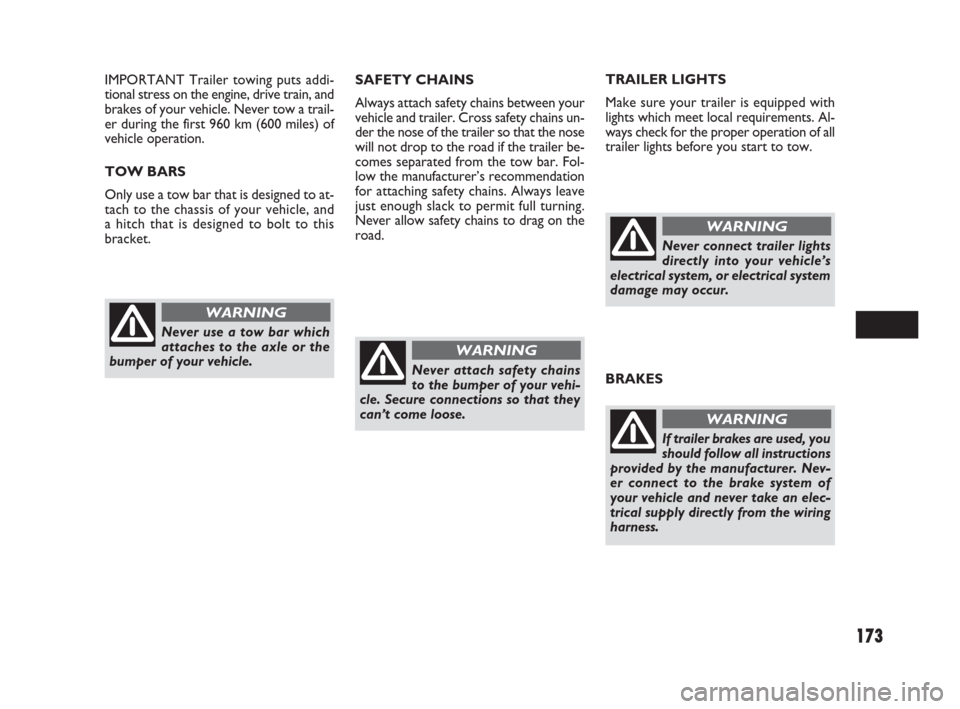
Never use a tow bar which
attaches to the axle or the
bumper of your vehicle.
WARNING
Never attach safety chains
to the bumper of your vehi-
cle. Secure connections so that they
can’t come loose.
WARNING
Never connect trailer lights
directly into your vehicle’s
electrical system, or electrical system
damage may occur.
WARNING
BRAKES
If trailer brakes are used, you
should follow all instructions
provided by the manufacturer. Nev-
er connect to the brake system of
your vehicle and never take an elec-
trical supply directly from the wiring
harness.
WARNING
173
SAFETY CHAINS
Always attach safety chains between your
vehicle and trailer. Cross safety chains un-
der the nose of the trailer so that the nose
will not drop to the road if the trailer be-
comes separated from the tow bar. Fol-
low the manufacturer’s recommendation
for attaching safety chains. Always leave
just enough slack to permit full turning.
Never allow safety chains to drag on the
road.TRAILER LIGHTS
Make sure your trailer is equipped with
lights which meet local requirements. Al-
ways check for the proper operation of all
trailer lights before you start to tow. IMPORTANT Trailer towing puts addi-
tional stress on the engine, drive train, and
brakes of your vehicle. Never tow a trail-
er during the first 960 km (600 miles) of
vehicle operation.
TOW BARS
Only use a tow bar that is designed to at-
tach to the chassis of your vehicle, and
a hitch that is designed to bolt to this
bracket.
171-180 Fiat16 New GB 3-09-2008 8:42 Pagina 173
Page 176 of 266
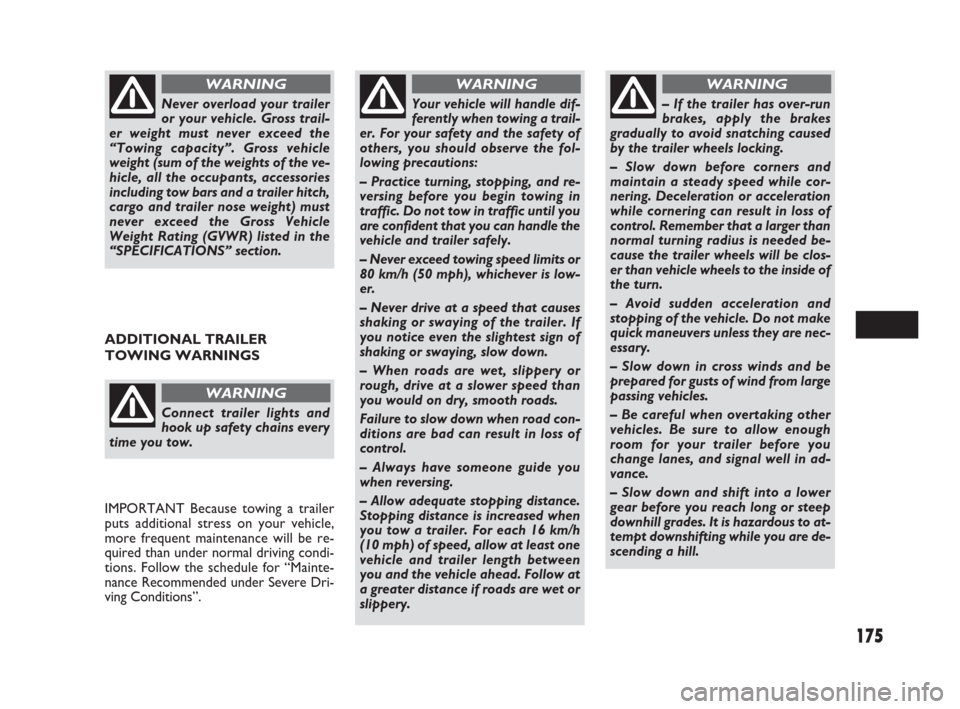
175
ADDITIONAL TRAILER
TOWING WARNINGS
Never overload your trailer
or your vehicle. Gross trail-
er weight must never exceed the
“Towing capacity”. Gross vehicle
weight (sum of the weights of the ve-
hicle, all the occupants, accessories
including tow bars and a trailer hitch,
cargo and trailer nose weight) must
never exceed the Gross Vehicle
Weight Rating (GVWR) listed in the
“SPECIFICATIONS” section.
WARNING
Connect trailer lights and
hook up safety chains every
time you tow.
WARNING
IMPORTANT Because towing a trailer
puts additional stress on your vehicle,
more frequent maintenance will be re-
quired than under normal driving condi-
tions. Follow the schedule for “Mainte-
nance Recommended under Severe Dri-
ving Conditions”.
Your vehicle will handle dif-
ferently when towing a trail-
er. For your safety and the safety of
others, you should observe the fol-
lowing precautions:
– Practice turning, stopping, and re-
versing before you begin towing in
traffic. Do not tow in traffic until you
are confident that you can handle the
vehicle and trailer safely.
– Never exceed towing speed limits or
80 km/h (50 mph), whichever is low-
er.
– Never drive at a speed that causes
shaking or swaying of the trailer. If
you notice even the slightest sign of
shaking or swaying, slow down.
– When roads are wet, slippery or
rough, drive at a slower speed than
you would on dry, smooth roads.
Failure to slow down when road con-
ditions are bad can result in loss of
control.
– Always have someone guide you
when reversing.
– Allow adequate stopping distance.
Stopping distance is increased when
you tow a trailer. For each 16 km/h
(10 mph) of speed, allow at least one
vehicle and trailer length between
you and the vehicle ahead. Follow at
a greater distance if roads are wet or
slippery.
WARNING
– If the trailer has over-run
brakes, apply the brakes
gradually to avoid snatching caused
by the trailer wheels locking.
– Slow down before corners and
maintain a steady speed while cor-
nering. Deceleration or acceleration
while cornering can result in loss of
control. Remember that a larger than
normal turning radius is needed be-
cause the trailer wheels will be clos-
er than vehicle wheels to the inside of
the turn.
– Avoid sudden acceleration and
stopping of the vehicle. Do not make
quick maneuvers unless they are nec-
essary.
– Slow down in cross winds and be
prepared for gusts of wind from large
passing vehicles.
– Be careful when overtaking other
vehicles. Be sure to allow enough
room for your trailer before you
change lanes, and signal well in ad-
vance.
– Slow down and shift into a lower
gear before you reach long or steep
downhill grades. It is hazardous to at-
tempt downshifting while you are de-
scending a hill.
WARNING
171-180 Fiat16 New GB 3-09-2008 8:42 Pagina 175
Page 185 of 266
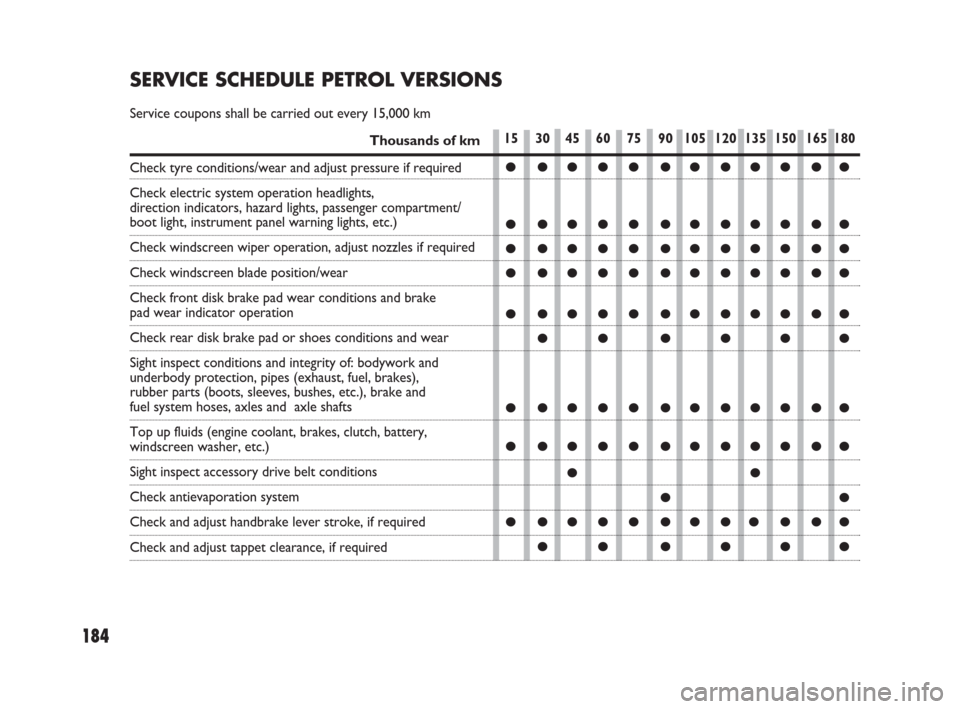
184
15 30 45 60 75 90 105 120 135 150 165 180
●●●●●●●●●●●●
●●●●●●●●●●●●
●●●●●●●●●●●●
●●●●●●●●●●●●
●●●●●●●●●●●●
●● ●●●●
●●●●●●●●●●●●
●●●●●●●●●●●●
●●
●●
●●●●●●●●●●●●
●● ●●●●
SERVICE SCHEDULE PETROL VERSIONS
Service coupons shall be carried out every 15,000 km
Thousands of km
Check tyre conditions/wear and adjust pressure if required
Check electric system operation headlights,
direction indicators, hazard lights, passenger compartment/
boot light, instrument panel warning lights, etc.)
Check windscreen wiper operation, adjust nozzles if required
Check windscreen blade position/wear
Check front disk brake pad wear conditions and brake
pad wear indicator operation
Check rear disk brake pad or shoes conditions and wear
Sight inspect conditions and integrity of: bodywork and
underbody protection, pipes (exhaust, fuel, brakes),
rubber parts (boots, sleeves, bushes, etc.), brake and
fuel system hoses, axles and axle shafts
Top up fluids (engine coolant, brakes, clutch, battery,
windscreen washer, etc.)
Sight inspect accessory drive belt conditions
Check antievaporation system
Check and adjust handbrake lever stroke, if required
Check and adjust tappet clearance, if required
181-224 Fiat16 New GB 3-09-2008 8:17 Pagina 184
Page 187 of 266
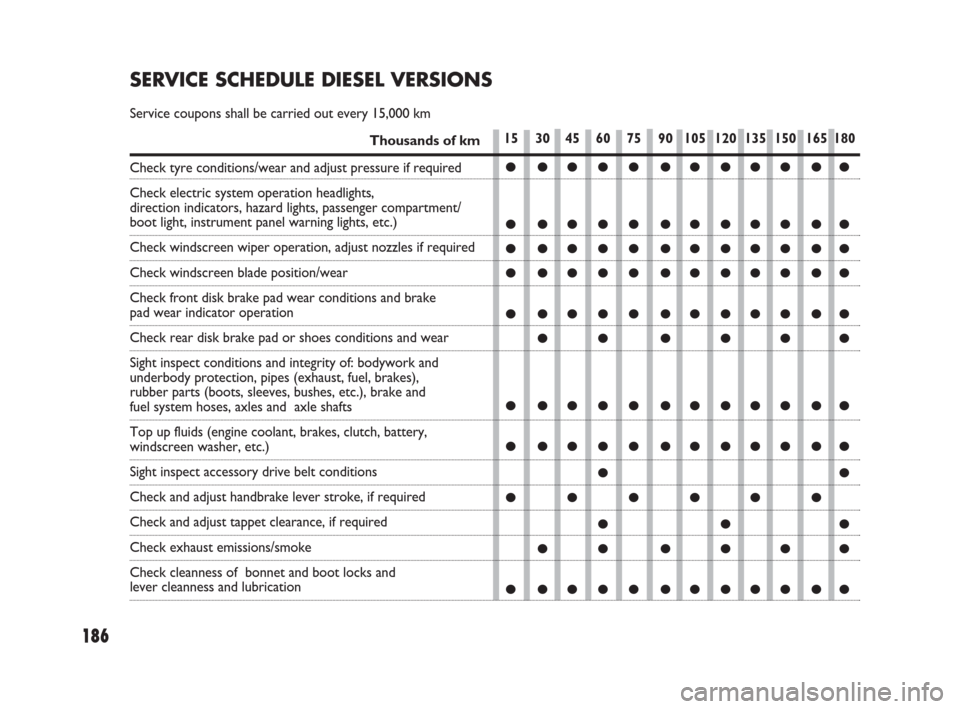
186
15 30 45 60 75 90 105 120 135 150 165 180
●●●●●●●●●●●●
●●●●●●●●●●●●
●●●●●●●●●●●●
●●●●●●●●●●●●
●●●●●●●●●●●●
●● ●●●●
●●●●●●●●●●●●
●●●●●●●●●●●●
●●
●●●●●●
●●●
●● ●●●●
●●●●●●●●●●●●
SERVICE SCHEDULE DIESEL VERSIONS
Service coupons shall be carried out every 15,000 km
Thousands of km
Check tyre conditions/wear and adjust pressure if required
Check electric system operation headlights,
direction indicators, hazard lights, passenger compartment/
boot light, instrument panel warning lights, etc.)
Check windscreen wiper operation, adjust nozzles if required
Check windscreen blade position/wear
Check front disk brake pad wear conditions and brake
pad wear indicator operation
Check rear disk brake pad or shoes conditions and wear
Sight inspect conditions and integrity of: bodywork and
underbody protection, pipes (exhaust, fuel, brakes),
rubber parts (boots, sleeves, bushes, etc.), brake and
fuel system hoses, axles and axle shafts
Top up fluids (engine coolant, brakes, clutch, battery,
windscreen washer, etc.)
Sight inspect accessory drive belt conditions
Check and adjust handbrake lever stroke, if required
Check and adjust tappet clearance, if required
Check exhaust emissions/smoke
Check cleanness of bonnet and boot locks and
lever cleanness and lubrication
181-224 Fiat16 New GB 3-09-2008 8:17 Pagina 186